英国文学史大纲
- 格式:doc
- 大小:47.50 KB
- 文档页数:5
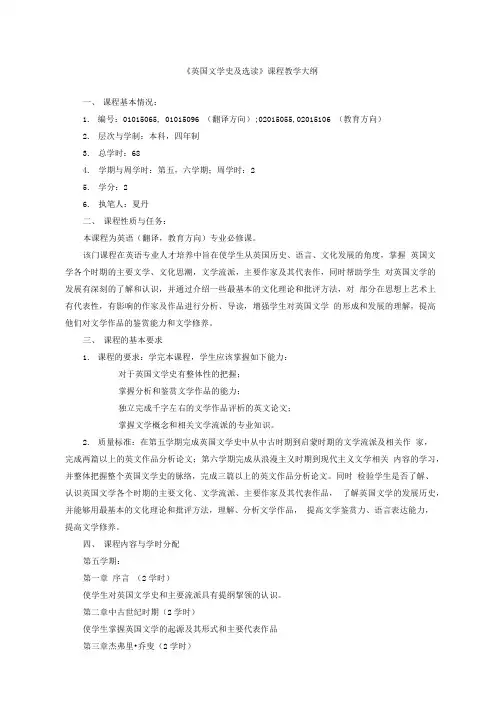
《英国文学史及选读》课程教学大纲一、课程基本情况:1.编号:01015065, 01015096 (翻译方向);02015055,02015106 (教育方向)2.层次与学制:本科,四年制3.总学时:684.学期与周学时:第五,六学期;周学时:25.学分:26.执笔人:夏丹二、课程性质与任务:本课程为英语(翻译,教育方向)专业必修课。
该门课程在英语专业人才培养中旨在使学生从英国历史、语言、文化发展的角度,掌握英国文学各个时期的主要文学、文化思潮,文学流派,主要作家及其代表作,同时帮助学生对英国文学的发展有深刻的了解和认识,并通过介绍一些最基本的文化理论和批评方法,对部分在思想上艺术上有代表性,有影响的作家及作品进行分析、导读,增强学生对英国文学的形成和发展的理解,提高他们对文学作品的鉴赏能力和文学修养。
三、课程的基本要求1.课程的要求:学完本课程,学生应该掌握如下能力:对于英国文学史有整体性的把握;掌握分析和鉴赏文学作品的能力;独立完成千字左右的文学作品评析的英文论文;掌握文学概念和相关文学流派的专业知识。
2.质量标准:在第五学期完成英国文学史中从中古时期到启蒙时期的文学流派及相关作家,完成两篇以上的英文作品分析论文;第六学期完成从浪漫主义时期到现代主义文学相关内容的学习,并整体把握整个英国文学史的脉络,完成三篇以上的英文作品分析论文。
同时检验学生是否了解、认识英国文学各个时期的主要文化、文学流派、主要作家及其代表作品,了解英国文学的发展历史,并能够用最基本的文化理论和批评方法,理解、分析文学作品,提高文学鉴赏力、语言表达能力,提高文学修养。
四、课程内容与学时分配第五学期:第一章序言(2学时)使学生对英国文学史和主要流派具有提纲挈领的认识。
第二章中古世纪时期(2学时)使学生掌握英国文学的起源及其形式和主要代表作品第三章杰弗里•乔叟(2学时)使学生对史诗《贝奥武甫》和杰弗里•乔叟的作品思想内容和艺术特色具有深入认识。
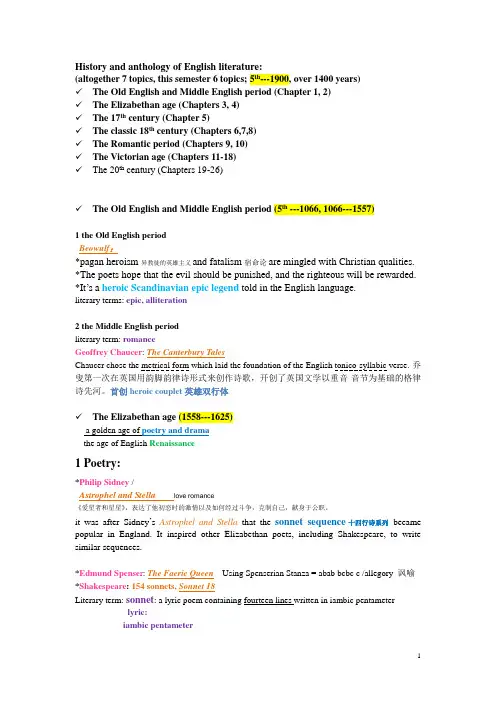
History and anthology of English literature:(altogether 7 topics, this semester 6 topics; 5th---1900, over 1400 years)✓The Old English and Middle English period (Chapter 1, 2)✓The Elizabethan age (Chapters 3, 4)✓The 17th century (Chapter 5)✓The classic 18th century (Chapters 6,7,8)✓The Romantic period (Chapters 9, 10)✓The Victorian age (Chapters 11-18)✓The 20th century (Chapters 19-26)✓The Old English and Middle English period (5th ---1066, 1066---1557)1 the Old English periodBeowulf:*pagan heroism异教徒的英雄主义and fatalism宿命论are mingled with Christian qualities. *The poets hope that the evil should be punished, and the righteous will be rewarded. *It’s a heroic Scandinavian epic legend told in the English language.literary terms: epic, alliteration2 the Middle English periodliterary term: romanceGeoffrey Chaucer: The Canterbury TalesChaucer chose the metrical form which laid the foundation of the English tonico-syllabic verse.乔叟第一次在英国用韵脚韵律诗形式来创作诗歌,开创了英国文学以重音-音节为基础的格律诗先河。
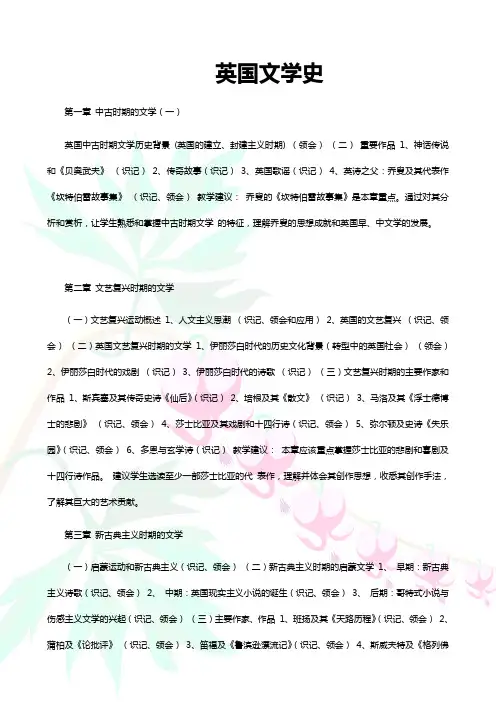
英国文学史第一章中古时期的文学(一)
游记》(识记、领会和应用)5、菲尔丁及《汤姆·琼斯》(识记)6、戏剧:哥德斯密斯和谢立丹(识记)教学建议:本章节要求学生结合启蒙运动的背景知识,了解新古典主义文学的主张和特点,体会启蒙运动对同时代英国文学的影响,理解并掌握班扬的作品《天路历程》的艺术特点,理解并掌握斯威夫
的特点,掌握《德伯家的苔丝》的思想内容,苔丝的形象,苔丝悲剧的根源,作品中的悲剧主义与宿命色彩。
建议教学时安排学生观看电影《苔丝》。
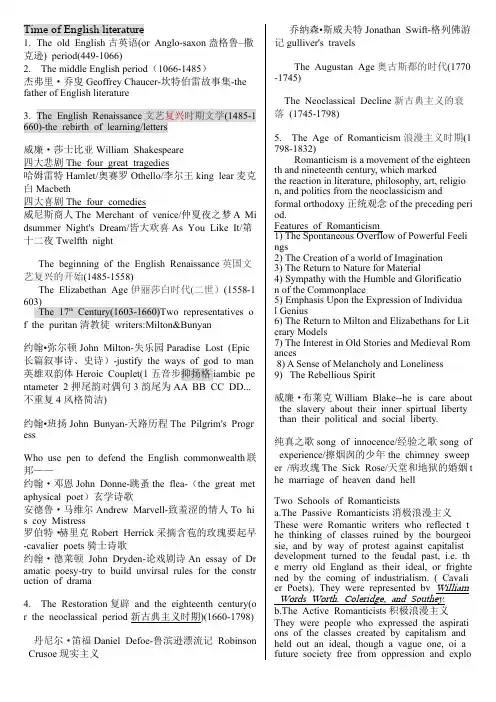
Time of English literature1.The old English古英语(or Anglo-saxon盎格鲁–撒克逊) period(449-1066)2.The middle English period(1066-1485)杰弗里·乔叟Geoffrey Chaucer-坎特伯雷故事集-the father of English literature3.The English Renaissance文艺复兴时期文学(1485-1 660)-the rebirth of learning/letters威廉·莎士比亚William Shakespeare四大悲剧The four great tragedies哈姆雷特Hamlet/奥赛罗Othello/李尔王king lear麦克白Macbeth四大喜剧The four comedies威尼斯商人The Merchant of venice/仲夏夜之梦A Mi dsummer Night's Dream/皆大欢喜As You Like It/第十二夜Twelfth nightThe beginning of the English Renaissance英国文艺复兴的开始(1485-1558)The Elizabethan Age伊丽莎白时代(二世)(1558-1 603)The 17th Century(1603-1660)Two representatives of t he puritan清教徒writers:Milton&Bunyan约翰·弥尔顿John Milton-失乐园Paradise Lost (Epic 长篇叙事诗、史诗)-justify the ways of god to man 英雄双韵体Heroic Couplet(1五音步抑扬格iambic pe ntameter 2押尾韵对偶句3韵尾为AA BB CC DD...不重复4风格简洁)约翰·班扬John Bunyan-天路历程The Pilgrim's Progr essWho use pen to defend the English commonwealth联邦——约翰·邓恩John Donne-跳蚤the flea-(the great met aphysical poet)玄学诗歌安德鲁·马维尔Andrew Marvell-致羞涩的情人To hi s coy Mistress罗伯特·赫里克Robert Herrick采摘含苞的玫瑰要起早-cavalier poets骑士诗歌约翰·德莱顿John Dryden-论戏剧诗An essay of Dr amatic poesy-try to build unvirsal rules for the constr uction of drama4.The Restoration复辟and the eighteenth century(o r the neoclassical period新古典主义时期)(1660-1798) 丹尼尔·笛福Daniel Defoe-鲁滨逊漂流记Robinson Crusoe现实主义乔纳森·斯威夫特Jonathan Swift-格列佛游记gulliver's travelsThe Augustan Age奥古斯都的时代(1770 -1745)The Neoclassical Decline新古典主义的衰落(1745-1798)5.The Age of Romanticism浪漫主义时期(1 798-1832)Romanticism is a movement of the eighteen th and nineteenth century, which markedthe reaction in literature, philosophy, art, religio n, and politics from the neoclassicism and formal orthodoxy 正统观念of the preceding peri od.Features of Romanticismngs2) The Creation of a world of Imagination3) The Return to Nature for Material4) Sympathy with the Humble and Glorification of the Commonplace5) Emphasis Upon the Expression of Individua l Genius6) The Return to Milton and Elizabethans for Lit erary Models7) The Interest in Old Stories and Medieval Rom ances8) A Sense of Melancholy and Loneliness9) The Rebellious Spirit威廉·布莱克William Blake--he is care about the slavery about their inner spirtual liberty than their political and social liberty.纯真之歌song of innocence/经验之歌song of experience/擦烟囱的少年the chimney sweep er /病玫瑰The Sick Rose/天堂和地狱的婚姻t he marriage of heaven dand hellTwo Schools of Romanticistsa.The Passive Romanticists消极浪漫主义These were Romantic writers who reflected t he thinking of classes ruined by the bourgeoi sie, and by way of protest against capitalist development turned to the feudal past, i.e. th e merry old England as their ideal, or frighte ned by the coming of industrialism. ( Cavali er Poets). They were represented bv William Words Worth. Coleridge, and Southey.b.The Active Romanticists积极浪漫主义They were people who expressed the aspirati ons of the classes created by capitalism and held out an ideal, though a vague one, oi a future society free from oppression and exploitation. These were vounaer and sometimes called act ive romanticistsrepresented bv Byron. Shelley, and Keats威廉·华兹华斯William Wordsworth-诗乃自发溢出的强烈情感Poetry is the spontaneous overflow of powe rful feelings.抒情歌谣集Lyrical Ballads咏水仙I Wandered Lonely as a CloudI wandered lonely as a cloudThat floats on high o’er vales and hills,When all at once I saw a crowd,A host, of golden daffodils;Beside the lake, beneath the trees,Fluttering and dancing in the breeze.Continuous as the stars that shineAnd twinkle on the milky way,They stretched in never-ending lineAlong the margin of a bay:Ten thousand saw I at a glance,Tossing their heads in sprightly dance.The waves beside them danced; but theyOut-did the sparkling waves in glee:A poet could not but be gay,In such a jocund company:I gazed --- and gazed --- but little thoughtWhat wealth the show to me had brought:For oft, when on my couch I lieIn vacant or in pensive mood,They flash upon that inward eyeWhich is the bliss of solitude;And then my heart with pleasure fills,And dances with the daffodils.珀西·比希·雪莱Percy Bysshe Shelley-西风颂Ode to the West Wind致云雀To a Skylark奥兹曼迪斯Ozymandias文学精神是政治和社会革命的诞生物Literary spirit as the accompaniment political and social revolution浪漫主义是文学的革命形式Romanticism is the literar y form of the revolution约翰·济慈John Keats-夜莺颂Ode to a Nightingale秋颂To Autumn简·奥斯汀Jane Austen-outward(生活平静)-inward(故事跌宕起伏)理智与情感Sense and Sensibility傲慢与偏见Pride and Prejudice-It is a truth universally acknowledged that a single man in possession of a good fortune must be in want of a wife. 凡是有钱的单身汉,总想娶位太太,这已经成了一条举世公认的道理。
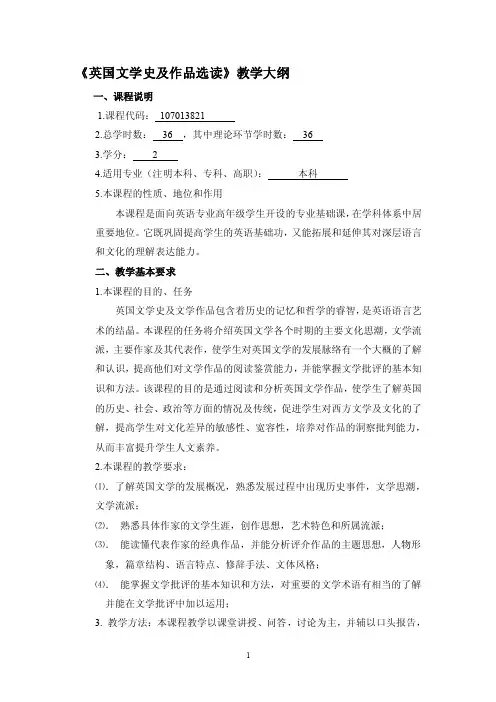
《英国文学史及作品选读》教学大纲一、课程说明1.课程代码:1070138212.总学时数:36 ,其中理论环节学时数:363.学分: 24.适用专业(注明本科、专科、高职):本科5.本课程的性质、地位和作用本课程是面向英语专业高年级学生开设的专业基础课,在学科体系中居重要地位。
它既巩固提高学生的英语基础功,又能拓展和延伸其对深层语言和文化的理解表达能力。
二、教学基本要求1.本课程的目的、任务英国文学史及文学作品包含着历史的记忆和哲学的睿智,是英语语言艺术的结晶。
本课程的任务将介绍英国文学各个时期的主要文化思潮,文学流派,主要作家及其代表作,使学生对英国文学的发展脉络有一个大概的了解和认识,提高他们对文学作品的阅读鉴赏能力,并能掌握文学批评的基本知识和方法。
该课程的目的是通过阅读和分析英国文学作品,使学生了解英国的历史、社会、政治等方面的情况及传统,促进学生对西方文学及文化的了解,提高学生对文化差异的敏感性、宽容性,培养对作品的洞察批判能力,从而丰富提升学生人文素养。
2.本课程的教学要求:⑴.了解英国文学的发展概况,熟悉发展过程中出现历史事件,文学思潮,文学流派;⑵.熟悉具体作家的文学生涯,创作思想,艺术特色和所属流派;⑶.能读懂代表作家的经典作品,并能分析评介作品的主题思想,人物形象,篇章结构、语言特点、修辞手法、文体风格;⑷.能掌握文学批评的基本知识和方法,对重要的文学术语有相当的了解并能在文学批评中加以运用;3. 教学方法:本课程教学以课堂讲授、问答,讨论为主,并辅以口头报告,课后作业和原版电影欣赏。
课堂讲授力求以启发式教学培养学生对作品的感悟领受能力。
口头报告要求学生从相关文献和网络查寻英国文学知识,整理成文并在课堂陈述,课后作业以作品的赏析评介为主,以小论文形式完成。
三、学时分配四、大纲内容(一)教学大纲内容Part I Anglo-Saxon Period Beowulf (450-1066)【本章教学目的、要求】:帮助学生了解古英语诗歌的源泉及其韵律特点。
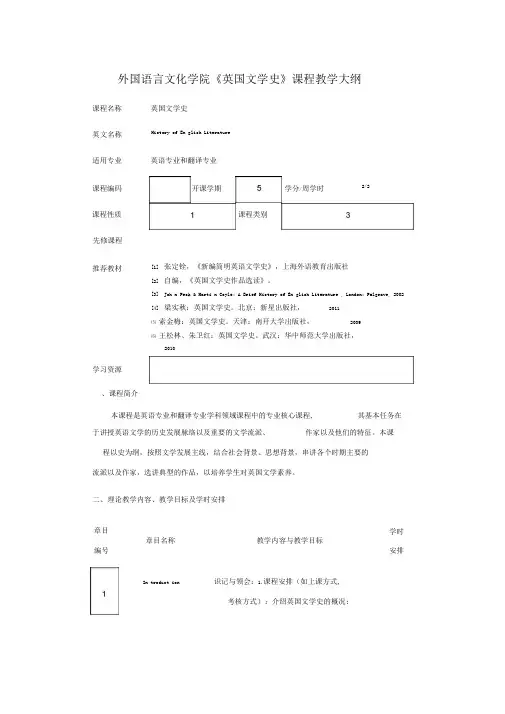
外国语言文化学院《英国文学史》课程教学大纲History of En glish Literature先修课程[1]张定铨,《新编简明英语文学史》,上海外语教育出版社[2]自编,《英国文学史作品选读》。
[3]Joh n Peck & Marti n Coyle: A Brief History of En glish Literature , London: Palgrave, 2002[4]梁实秋:英国文学史。
北京:新星出版社,2011⑸ 索金梅:英国文学史。
天津:南开大学出版社,2009⑹ 王松林、朱卫红:英国文学史。
武汉:华中师范大学出版社,2010、课程简介本课程是英语专业和翻译专业学科领域课程中的专业核心课程,于讲授英语文学的历史发展脉络以及重要的文学流派、作家以及他们的特征。
本课程以史为纲,按照文学发展主线,结合社会背景、思想背景,串讲各个时期主要的流派以及作家,选讲典型的作品,以培养学生对英国文学素养。
二、理论教学内容、教学目标及学时安排章目学时编号章目名称In troduct ion教学内容与教学目标安排识记与领会:1.课程安排(如上课方式,考核方式);介绍英国文学史的概况;课程名称英国文学史英文名称适用专业英语专业和翻译专业课程编码学分/周学时2/2课程性质课程类别推荐教材学习资源其基本任务在开课学期3.介绍诗歌的基本要素简单应用:英国文学史概况,各类文学体裁的基本要素Old and Middle En glishLiterature 识记与领会:Beowulf, short lyrics,Medieval Roma nces. Ballads, Lan gla nd.Malory, Chaucer简单应用:古英语和中古英语文学发展及特性阅读教材:chapter 1阅读作品:Geoffrey Chaucer,TheCan terbury Tales 选段Ren aissa nee En glishLiterature 识记与领会:16th Cen tury poetry and p rose, Shakespeare, Other playwrights,戏剧的基本要素简单应用:文艺复兴时期英语文学发展及特性阅读教材:chapter 2 [I, II (1-3)] & chapter阅读作品:William Shakespeare,Sonnet 18, Romeo and Juliet 选段,Hamlet 选段17th Cen tury En glishLiterature 识记与领会:Do nne, Marvel, Bu nyan,Milt on, Dryden简单应用:17世纪英语文学发展及特性阅读教材:chap ter 2 [II (4), III, IV, V (1)], cha pter 4 (IV), cha pter 5 (I), cha pter 6(I,II)阅读作品:John Donne, “The Flea ” ; John Milton, Paradise Lost 选段18th Cen tury En glishLiterature 识记与领会:Alexa nder Pope, SamuelJoh nson, the Rise of Novel from AphraBehn to Jane Austen,小说的基本要素简单应用:18世纪英语文学发展及特性阅读教材:chapter 2 [V(2)], cha pter 5, cha pter 6 (III), cha pter 8 (II), chapter 10(I)阅读作品:Daniel Defoe, Robinson Crusoe 选段,Jane Austen, Pride and Prejudice选段Roma ntic Literature 识记与领会:Blake, Wordsworth, Coleridge,Byro n, Shelley, Keats简单应用:特性阅读教材:8 (III)阅读作品:浪漫主义时期英语文学发展及cha pter 7, cha pter 10 (II), cha pterWilliam Wordsworth, “ I wan dere Ionely as a cloud ,P. ” Shelley, Ode tothe West WindVictoria n Literature 识记与领会:Novelists: Dicke ns, the Bron tes,G. Eliot, Thackeray, Gaskell, Hardy;Po ets: Tennyson, the Brow nin gs; Drama:Bernard Shaw, O. Wilde简单应用:维多利亚时期英语文学发展及特性阅读教材:chapter 8 (III-VI), cha pter 9, cha pter 10 (III), cha pter 11, cha pter 12(I-V), cha pter 13 (II, III)Moder nist Literature 阅读作品:Charles Dicke ns. GreatExpectation 选段,Thomas Hardy, Tess ofthe d ' Urbervill选段识记与领会:Co nrad, Lawre nee, Woolf, Joyce, Yeats, Eliot, Aude n简单应用:现代主义时期英语文学发展及特性阅读教材:chapter (VI), cha pter 13 (IV, V, VI, VII), chapter 14, chapter 15, cha pter16阅读作品:Virgi nia Woolf, Mrs. Dalloway 选段,T. S. Eliot, The Love Song of J.Alfred P rufrockAfter Moder nism三、教学方式与方法教师课堂讲授;学生课堂讨论四、考核方式闭卷考试五、成绩评定方式识记与领会:Postmoder nist no velists, the Moveme nt Poetry, Heaney简单应用:现代主义之后的英语文学发展及特性阅读教材:chapter 17, chapter 18阅读作品:William Goldi ng, Lord of the Flies 选段,Samuel Beckett, Waiting forGodot选段学期考试成绩占60%,期中论文30% (1500字,abstract和参考书目不算字数,期中交,交打印版,William Shakespeare 的Romeo and Juliet, Hamlet,John Donne的the flea, Jane Austen 的Pride and Prejudice 四选一),平时考查成绩占10%(分小组做Presentation,小组得分即个人得分)。
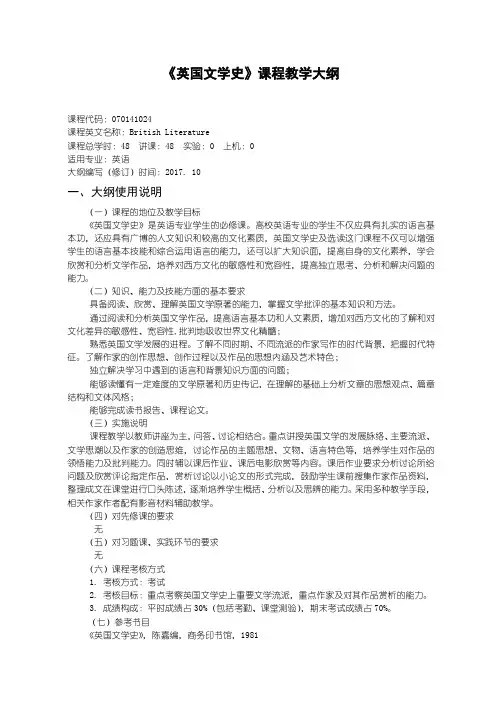
《英国文学史》课程教学大纲课程代码:070141024课程英文名称:British Literature课程总学时:48 讲课:48 实验:0 上机:0适用专业:英语大纲编写(修订)时间:2017. 10一、大纲使用说明(一)课程的地位及教学目标《英国文学史》是英语专业学生的必修课。
高校英语专业的学生不仅应具有扎实的语言基本功,还应具有广博的人文知识和较高的文化素质,英国文学史及选读这门课程不仅可以增强学生的语言基本技能和综合运用语言的能力,还可以扩大知识面,提高自身的文化素养,学会欣赏和分析文学作品,培养对西方文化的敏感性和宽容性,提高独立思考、分析和解决问题的能力。
(二)知识、能力及技能方面的基本要求具备阅读、欣赏、理解英国文学原著的能力,掌握文学批评的基本知识和方法。
通过阅读和分析英国文学作品,提高语言基本功和人文素质,增加对西方文化的了解和对文化差异的敏感性、宽容性,批判地吸收世界文化精髓;熟悉英国文学发展的进程。
了解不同时期、不同流派的作家写作的时代背景,把握时代特征。
了解作家的创作思想、创作过程以及作品的思想内涵及艺术特色;独立解决学习中遇到的语言和背景知识方面的问题;能够读懂有一定难度的文学原著和历史传记,在理解的基础上分析文章的思想观点、篇章结构和文体风格;能够完成读书报告、课程论文。
(三)实施说明课程教学以教师讲座为主,问答、讨论相结合。
重点讲授英国文学的发展脉络、主要流派、文学思潮以及作家的创造思维,讨论作品的主题思想、文物、语言特色等,培养学生对作品的领悟能力及批判能力。
同时辅以课后作业、课后电影欣赏等内容。
课后作业要求分析讨论所给问题及欣赏评论指定作品,赏析讨论以小论文的形式完成,鼓励学生课前搜集作家作品资料,整理成文在课堂进行口头陈述,逐渐培养学生概括、分析以及思辨的能力。
采用多种教学手段,相关作家作者配有影音材料辅助教学。
(四)对先修课的要求无(五)对习题课、实践环节的要求无(六)课程考核方式1. 考核方式:考试2. 考核目标:重点考察英国文学史上重要文学流派,重点作家及对其作品赏析的能力。
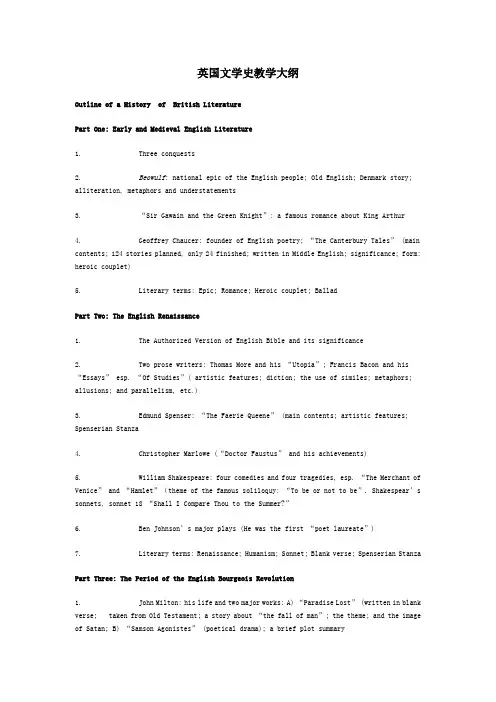
英国文学史教学大纲Outline of a History of British LiteraturePart One: Early and Medieval English Literature1. Three conquests2. Beowulf: national epic of the English people; Old English; Denmark story; alliteration, metaphors and understatements3. “Sir Gawain and the Green Knight”: a famous romance about King Arthur4. Geoffrey Chaucer: founder of English poetry; “The Canterbury Tales” (main contents; 124 stories planned, only 24 finished; written in Middle English; significance; form: heroic couplet)5. Literary terms: Epic; Romance; Heroic couplet; BalladPart Two: The English Renaissance1. The Authorized Version of English Bible and its significance2. Two prose writers: Thomas More and his “Utopia”; Francis Bacon and his “Essays” esp. “Of Studies”( artistic features; diction; the use of similes; metaphors; allusions; and parallelism, etc.)3. Edmund Spenser: “The Faerie Queene” (main contents; artistic features; Spenserian Stanza4. Christophe r Marlowe (“Doctor Faustus” and his achievements)5. William Shakespeare: four comedies and four tragedies, esp. “The Merchant of Venice” and “Hamlet”(theme of the famous soliloquy: “To be or not to be”. Shakespear’s sonnets, sonnet 18 “Shall I Compare Thou to the Summer?”6. Ben Johnson’s major plays (He was the first “poet laureate”)7. Literary terms: Renaissance; Humanism; Sonnet; Blank verse; Spenserian StanzaPart Three: The Period of the English Bourgeois Revolution1. John Milton: his life and two major works: A) “Paradise Lost” (written in blank verse; taken from Old Testament; a story about “the fall of man”; the theme; a nd the image of Satan; B) “Samson Agonistes” (poetical drama); a brief plot summary2. John Bunyan: “The Pilgrim’s Progress”3. Founder of the Metaphysical school: John Donne; features of the school: philosophical poems, complex rhythms and strange images4. John Dryden: “All for Love”(a tragedy); “An Essay of Dramatic Poesy”(Literary criticism); forerunner of the Classicism in BritainPart Four: The Eighteen Century1. The Enlightenment Movement2. Alexander Pope: “Essay on Criticism”, “Essay on Man”, “The Rape of Lock”, “The Dunciad”; his workmanship (features) and limitations3. Samuel Johnson: “Dictionary of English Language”4. Jonathan Swift: “Gulliver’s Travels” (the story)5. The rise and growth of the realistic novel is the most prominent achievement of 18th century English literature.6. Daniel Defoe: “Robinson Crusoe” (the story; character analysis of Robinson Crusoe and Friday; Defoe’s style and feature)7. Henry Fielding (fath er of the English novel): his major novels: “Joseph Andrews”, “Jonathan Wild”, “Tom Jones”(story, character and theme); Fielding’s literary theory about the English Realistic novel; his features.8. Thomas Gray: a representative of sentimentalism and graveyard school of poets: “Elegy Written in a Country Churchyard”9. In the latter half of the 18th century appeared Pre-Romanticism; representative: William Blake and Robert Burns. William Blake: “Songs of Innocence” and “Songs of Experience” (What is the difference between the two?); Robert Burns: a Scottish poet; a poet of peasant and Scottish people; plain language; influence from Scottish folk songs and ballads; musical quality of his poems; the use of Scottish dialect; his famous poems inc lude “A Red, Red Rose”, “Auld Lang Syne”10. Literary terms: Enlightenment; Classicism; Sentimentalism;Part Five: Romanticism in England (1798 – 1832)1. What are the features of Romanticism?2. William Wordsworth: The preface to“Lyrical Ballads” (1798)marked the beginning of British Romanticism; one of the Lake Poets; his thematic concerns: nature and common people’s lives; his major works; his short poems like “I wandered lonely as a cloud”, etc.3. Samuel Taylor Coleridge: his major poems: The Rime of the Ancient Mariner; Kubla Khan; the supernatural elements in his poems4. George Gordon Byron: his life and major works: “Child Harold’s Pilgrimage” and “Don Juan” (the contents, written in Spenserian Stanza); Byronic H eroes5. Percy Bysshe Shelley: his major works: Queen Mab; The Revolt of Islam; Prometheus Unbound (lyrical drama); his famous poems: Ode to the West Wind (theme and artistic features); To a skylark; etc.6. John Keats: Ode to Autumn; Ode to a Nightingale; Ode on a Grecian Urn”(contents, and artistic features)7. Walter Scott: founder and great master of the historical novel; his death marks the ending of Romantic Period in English literature; famous novels: Rob Roy, Ivanhoe; features of his novels8. Literary terms: Romanticism; Byronic HeroesPart Six: English Critical Realism1. What is Critical Realism? (origin; features and representative writers)2. Charles Dickens (very important): his life and major wo rks: “The Pickwick Papers”(first novel); “Oliver Twist” (main contents; characters and significance); “David Copperfield” (main contents; characters and significance); “A Tales of Two Cities” (main contents; characters and significance). Features of Dick ens’s works3. William Makepeace Thackeray: Vanity Fair (named after John Bunyan’s “The Pilgrim’s Progress” ; what does the subtitle “A novel without a hero” mean?; the story; main characters; artistic features)4. Jane Austen; her six novel s; “Pride and Prejudice” (contents and characters); Austen’s style:thin plot, mostly everyday life of simple country society; good at writing young girls; modest satire; witty dialogues5. Charlotte Bronte: “Jane Eyre” (story; character analysis of Jane Eyre;)6. Emily Bronte: “Wuthering Heights” (story, main characters; Emily’s writing style)7. Mrs. Gaskell, one of the first English writers to describe the class struggle in a novel, famous novel: “Mary Barton”.8. George Eli ot: “Adam Bede”, “The Mill on Floss”, “Silas Marner”9. Literary terms: Critical realismPart Seven: Prose-writers and poets of the mid and later 19th century1. Three prose writers: Thomas Carlyle, John Ruskin, Matthew Arnold2. Alf red Tennyson: “In Memoriam”, “The Idylls of the Kings”;short poem: “Break, Break, Break” (theme; artistic features)3. Robert Browning introduced dramatic monologue to poetry4. Elizabeth Barrett Browning: “Sonnets from the Portuguese”.5. Oscar Wilde: his major plays6. Literary terms: AestheticismPart Eight: Twentieth Century English Literature1. Thomas Hardy: Wes*** novels; major novels: “Tess of D’Urberville”(story; characters; and theme); “Far from the Madding Crowd”, “Jude the Obscure”; Hardy’s characteristics2. John Galsworthy: “The Forsyte Saga” (trilogy)3. George Bernard Shaw (a realistic playwright): Irish-born; social reformist; major plays “Mrs Warren’s Profession” and “Major Babara”; “Saint Joan”, etc4. Joseph Conrad (pioneer of Modernistic novels): “Lord Jim”; “Heart of Darkness”5. Henry James (forerunner of “stream of consciousness”); “Daisy Miller”; “The Portrait of a Lady”; “The Ambassador”; “The Golden Bowl”, etc.6. Two modernistic poets: William Butler Yeats and T. S. Eliot (major works: “The Waste Land”, the contents, themes; and artistic features)7. Modernist fiction put emphasis on the description of the characters’ psychological activities under t he influence of Austrian doctor Sigmund Freud’s theories.8. D. H. Lawrence: major works: “Sons and Lovers” (story; characters and theme; “Oedipus complex” ) ; “The Rainbow” ; “Women in Love” ; “Lady Chatterley’s Lover”; Lawrence’s writing style9. James Joyce: “Ulysses” (plot; character and writing style) “ Finnegans Wake”10. Virginia Woolf: “To the Lighthouse”; “Mrs. Dalloway”11. Literary term: Imagism; Stream-of-consciousness; Modernism。
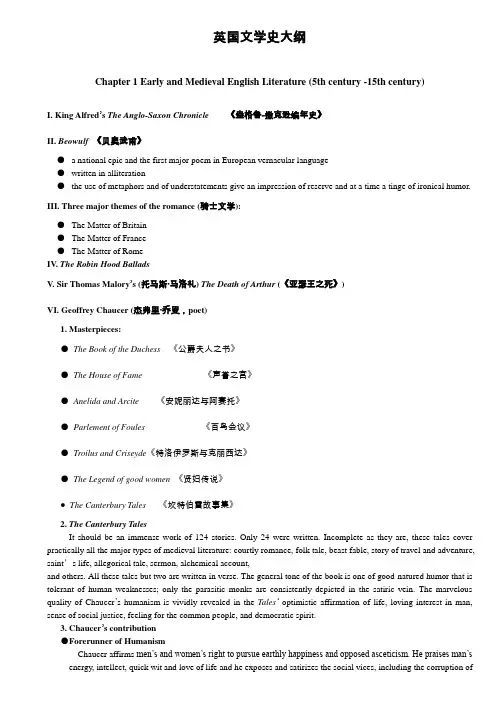
英国文学史大纲Chapter 1 Early and Medieval English Literature (5th century -15th century)I. King Alfred’s The Anglo-Saxon Chronicle《盎格鲁-撒克逊编年史》II. Beowulf《贝奥武甫》● a national epic and the first major poem in European vernacular language●written in alliteration●the use of metaphors and of understatements give an impression of reserve and at a time a tinge of ironical humor. III. Three major themes of the romance (骑士文学):●The Matter of Britain●The Matter of France●The Matter of RomeIV. The Robin Hood BalladsV. Sir Thomas Malory’s (托马斯·马洛礼) The Death of Arthur (《亚瑟王之死》)VI. Geoffrey Chaucer (杰弗里·乔叟,poet)1. Masterpieces:●The Book of the Duchess《公爵夫人之书》●The House of Fame 《声誉之宫》●Anelida and Arcite《安妮丽达与阿赛托》●Parlement of Foules《百鸟会议》●Troilus and Criseyde《特洛伊罗斯与克丽西达》●The Legend of good women《贤妇传说》●The Canterbury Tales《坎特伯雷故事集》2. The Canterbury TalesIt should be an immense work of 124 stories. Only 24 were written. Incomplete as they are, these tales cover practically all the major types of medieval literature: courtly romance, folk tale, beast fable, story of travel and adventure, saint’s life, allegorical tale, sermon, alchemical account,and others. All these tales but two are written in verse. The general tone of the book is one of good-natured humor that is tolerant of human weaknesses; only the parasitic monks are consistently depicted in the satiric vein. The marvelous quality of Chaucer’s humanism is vividly revealed in the Tales’ optimistic affirmation of life, loving interest in man, sense of social justice, feeling for the common people, and democratic spirit.3. Chaucer’s contribution●Forerunner of HumanismChaucer affirms men’s and women’s right to pursue earthly happiness and opposed asceticism. He praises man’s energy, intellect, quick wit and love of life and he exposes and satirizes the social vices, including the corruption of the Church.●The founder of English RealismChaucer, for the first time in English literature, presents to the readers a comprehensive realistic picture of the English society of his time and describes a series of vivid characters from all walks of life in The Canterbury Tales.●Father of English poetryChaucer introduces from France the rhymed stanzas of various types to English poetry to replace the old English alliterative verse. He is the first to use the rhymed couplet of iambic pentameter, which is to be called the heroic couplet. Thus, he lays the foundation of the English tonic-syllabic verse.●Master of the English languageChaucer is the first great poet who wrote in the current English. His production of so much excellent poetry is an important factor in establishing English as the literary language of the country. Chaucer uses London dialect in his writings and he contributes to making it the foundation for modern English speech.Chapter 2 English Literature of the Renaissance (1500-1640)I. The Renaissance/the rebirth of lettersThe English Renaissance was a cultural and artistic movement in England dating from the early 16th century to the early 17th century. The most important characteristics of this movement are the exaltation of man and an absorption in earthly life. The humanists expressed their admiration for human beauty and human achievement. They believed that man could mould the world according to his will and attain happiness by removing the external check. II. Thomas Moore’s (托马斯·莫尔) Utopia (《乌托邦》)III. Edmund Spenser’s (埃德蒙·斯宾塞, the poet’s poet) The Shephearde’s Calender (《牧羊人日记》) and The Faerie Queene (《仙后》)IV. Francis Bacon (弗朗西斯·培根,scientist, thinker, philosopher and essayist)1. Masterpieces●The Advancement of Learning (《学术的进步》)●Novum Organum (New Instrument) (《新工具论》)●The Essays (《论说文集》)2. Bacon’s contribution●The founder of English materialist philosophy, and the father of Empiricism●The founder of modern science in England●The first English essayistV. William Shakespeare (威廉·莎士比亚,dramatist)1. Shakespeare’s literary career●The First Period (1590-1600)1) 1590-1594 (the period of his apprenticeship in play): historical play; varieties of comedy; the revenge tragedy andthe romantic tragedyHenry VI (《亨利六世》)Richard III (《理查德三世》)The Comedy of Errors (《错误的喜剧》)Titus Andronicus (《泰特斯·安德洛尼斯》)The Taming of the Shrew (《驯悍记》)The Two Gentlemen of Verona (《维洛纳二绅士》)Love’s Labour’s Lost (《爱的徒劳》)Romeo and Juliet (《罗密欧与朱丽叶》)2)1595-1600 (mature period): a period of “great comedies”and mature historical plays (four great comedies: AMidsummer Night’s Dream; The Merchant of Venice; As You Like It; Twelfth Night)Richard II (《理查德二世》)A Mid-Summer Night’s Dream (《仲夏夜之梦》)King John (《约翰王》)The Merchant of Venice (《威尼斯商人》)Henry IV (《亨利四世》)Much Ado About Nothing (《无事生非》)Henry V (《亨利五世》)The Merry Wives of Windsor (《温莎的风流娘儿们》)Julius Caesar (《裘力斯·凯撒》)As You Like It (《皆大欢喜》)Twelfth Night (《第十二夜》)●The Second Period (1601-1608): the period of “great tragedies”and “dark comedies”(荒诞喜剧) (four greattragedies: Hamlet; Othello; King Lear; Macbeth)Hamlet (《哈姆雷特》)Troilus and Cressida (《特洛伊斯与克瑞西达》)All’s Well That Ends Well (《终成眷属》)Measure for Measure (《一报还一报》)Othello (《奥赛罗》)King Lear (《李尔王》)Macbeth (《麦克白》)Antony and Cleopatra (《安东尼与克莉奥佩特拉》)Coriolanus (《科利奥兰纳斯》)Timon of Athens (《雅典的泰门》)Pericles (《泰尔亲王佩力克斯》)●The Third Period (1609-1612): the period of romantic dramaCymbeline (《辛白林》)The Winter’s Tale (《冬天的故事》)The Tempest (《暴风雨》)Henry VIII (《亨利八世》)2. Features of Shakespeare's Dramatic Works●Shakespeare is one of the founders of realism in the world literature. He described the decaying of the feudalsociety and the rising of the bourgeois spirit.●Shakespeare borrowed his plots from old stories of Greek and Roman, Italian and English.●Shakespeare’s dramatic works are very elastic. The action develops freely, without being hindered by the classicalrules of three unities (i.e. unities of time, place, and action)●Shakespeare was skilled in many poetic forms: the Song, the sonnet, the couplet, and the dramatic blank verse.●Shakespeare was a great master of English language. In his drama, he used about 16,000 words. Many of his newcoinages and turns of expression have become everyday usage in English life.3. Shakespeare’s contribution●Shakespeare has been universally acknowledged to be the summit of the English Renaissance, and one of thegreatest writers the world over. He is also widely regarded as the greatest writer of English language and the world’s pre-eminent dramatist.●He transformed English theatre by expanding expectations about what could be accomplished throughcharacterization, plot, language and genre.●Shakespeare's writings have also influenced a large number of notable novelists and poets over the years.VI. Ben Jonson (本·琼生,poet, playwright and critic)1. Masterpieces●Every Man in His Humour《个性互异》/《人各有癖》●Every Man out of His Humour《个性使然》/《人各有怨》●Cynthia’s Revels《辛西娅的狂欢》●The Poetaster《冒牌诗人》●Volpone, or the Fox 《伏尔蓬奈》/《狐狸》●The Alchemist《炼金士》●Bartholomew Fair《巴索洛缪市场》2. Ben Jonson’s contributionComedies of humours: a “humour”is a predominant peculiarity of a certain person, which determines his behaviour, thoughts and manner of speech.V. Christopher Marlowe (克里斯多弗·马洛,a playwright of “university wits”)1. Masterpieces●Dido, Queen of Carthage《迦太基女王狄多》●Tamburlaine《帖木儿》●The Jew of Malta《马耳他的犹太人》●The Tragical History of Doctor Faustus《浮士德博士的悲剧》2. Social significance of Marlowe’s plays●These plays show, in various ways, the spirit of the rising bourgeoisie, its eager curiosity for knowledge, itstowering pride, its insatiable appetite for power whether that be won by military might, knowledge, or gold.●The theme of Marlowe’s plays is the praise of individuality freed from the restraints of medieval dogmas andlaw, and the conviction of the boundless possibility of human efforts in conquering the universe.●However, the heroes in Marlowe’s plays are merely individualists. Their individualistic ambition often bringsruin to the world and sometimes to themselves.3. Marlowe’s contribution●He was the greatest of the pioneers of English drama. He reformed the English drama and perfected the language and verse of dramatic works. It is Marlowe who first made blank verse (rhymeless iambic pentameter) the principal instrument of English drama.●Marlowe’s dramatic achievement lies chiefly in his epical, and at times lyrical, verse. He was famous for his“mighty line”. It is mighty and plastic.●His work paved the way for the plays of the greatest English dramatist—Shakespeare.Chapter 3 English Literature during the English Bourgeois Revolution and the Restoration(1640-1688)I. The Metaphysical Poets & the Cavalier Poets1. The Metaphysical Poets●John Donne (约翰·邓恩)●Andrew Marvell (安德鲁·马维尔)2. The Cavalier Poets●Robert Herrick (罗伯特·赫里克)●John Dryden (约翰·德莱顿)II. John Milton (约翰·弥尔顿,poet)1. Masterpieces●L’Allegro 《欢乐的人》∕《欢乐颂》●IL Penseroso《沉思的人》∕《沉思颂》●Lycidas《黎西达斯》●Comus 《考玛斯》●On his Blindness 《失明》●On his Deceased Wife《悼亡妻》●Paradise Lost《失乐园》●Paradise Regained 《复乐园》●Samson Agonistes 《力士参孙》●Areopagitica《论出版自由》2. Paradise LostParadise lost is a long epic in 12 books, written in blank verse. The stories were taken from the Old Testament: the creation; The rebellion in Heaven of Satan and his fellow-angels; their defeat and expulsion from Heaven; the creation of the earth and of Adam and Eve; the fallen angels in hell plotting against God; Satan’s temptation of Eve; and the departure of Adam and Eve from Eden. The picture of God surrounded by his angels, who never think of expressing any opinions of their own, resembles the court of an absolute monarch, while Satan and his followers, who freely discuss all issues in council, bear close resemblance to a republican Parliament. This alone is sufficient to prove that Milton’s revolutionary feelings made him forsake religious orthodoxy.3. Milton’s contribution●He was a militant pamphleteer of the English Revolution, and the greatest English revolutionary poet of 17thcentury.●He wrote the greatest epic in English literature.●He is a master of the blank verse.●He is a great stylist. (grand style)●Milton has always been admired for his sublimity of thought and majesty of expression.III. John Bunyan (约翰·班扬,Christian writer)1. Masterpieces●Prison Meditations《狱中沉思》●Grace Abounding to the Chief of Sinners 《丰盛的恩典》/《罪人受恩记》●The Pilgrim’s Progress 《天路历程》●The Life and Death of Mr. Badman 《坏人先生传》●The Holy War 《圣战》● A Holy Life 《圣洁的生活》2. The Pilgrim’s ProgressThe Pilgrim’s Progress is a Christian allegory published in 1678. It is regarded as one of the most significant works of religious English literature. It is a religious allegory. Though an allegory, its characters impress the reader like real persons. In this book, Bunyan cherished a deep hatred of both the king and his government. His prose is admirable. It is popular speech ennobled by the solemn dignity and simplicity of the language of the English Bible.Chapter 4 Eighteenth Century English Literature (1688-1789)I. The EnlightenmentThe Enlightenment, a progressive intellectual movement throughout Western Europe in the eighteenth century, spread into England. The Enlighteners considered “enlightenment”or “education”of the people to be their chief mission. They believed in the power of reason, rather than emotion. The eighteenth century is thus known as “the Age of Reason”.●The moderateThe moderate group supported the principles of the existing social order and considered partial reforms adequate. The most important writers of this group include Alexander Pope (亚历山大·蒲柏), Daniel Defoe (丹尼尔·笛福), Joseph Addison (约瑟夫·艾迪生), Richard Steele (理查德·斯梯尔), and Samuel Richardson (塞缪尔·理查逊).●The radicalThe radical wing struggled for more resolute democratization in the management of the government and even partly defended the interests of the exploited. The representatives of this group include Jonathan Swift (乔纳森·斯威夫特), Henry Fielding (亨利·菲尔丁),Tobias Smollett (托比亚斯·斯摩莱特), Richard Brinsley Sheridan (理查德·布林斯利·谢里丹), and Oliver Goldsmith (奥利弗·哥德史密斯).II. Neo-classicism (the early eighteenth century)Neo-classicism as a literary trend first originated in France. Boileau’s (布瓦洛) L’Art Poetique (《诗的艺术》) is considered as the declaration of Neo-classicism. Main characteristics of Neo-classicism can be summarized as follows: emphasis on reason rather than emotion; preference for elegance, correctness, symmetry, clearness and appropriateness; focus on “town”and “society”instead of nature or country things. The Neo-classicists modeled themselves after Greek and Latin authors, and tried to control literary creation by some fixed laws and rules drawn from Greek and Latin works. The representatives of this literary trend include Addison, Steele, Pope and Johnson. Johnson’s Dictionary (A Dictionary of the English Language,《约翰逊字典》) marked an epoch in the study of English language and the end of English writers’ reliance on the patronage of noblemen for support.III. Sentimentalism in English poetry and prose (the middle of the eighteenth century)Sentimentalism presented a new view of human nature which prized feeling over thinking, passion over reason, and personal instincts of “pity, tenderness, and benevolence” over social duties. Gray (格雷), Goldsmith, Sterne (斯特恩) and Richardson are representatives of this school. They were discontent with the social reality and the so-called reason. They criticized the cruelty of the capitalist society and its injustices, and they appeal to “sentiment”and “human heart”. They were sympathetic for the poverty-stricken peasants. Sentimentalism marks a transition from Neo-classicism to Romanticism in English poetry.IV. The beginning of modern novelPeople generally hold that the modern European novel started after the Renaissance with Cervante’s (塞万提斯) Don Quixote (《堂吉诃德》). The forerunners of English novel in this period were Defoe, Swift, Richardson, Fielding, Smollett and Sterne.1. Daniel Defoe (丹尼尔·笛福, writer, journalist and pamphleteer)He is notable for being one of the earliest proponents of the novel, as he helped to popularize the form in Britain, and is even referred to by some as among the founders of the English novel.●Paper & Pamphlet:The Review (《评论》) made him sometimes called father of modern journalism.The Shortest Way with the Dissenters (《消灭不同教派的捷径》)●MasterpiecesCaptain Singleton《辛格尔顿船长》The Life and Strange Surprising Adventures of Robinson Crusoe《鲁宾逊漂流记》Colonel Jacque《杰克上校》Moll Flanders 《摩尔·弗兰德斯》A Journal of the Plague Year《瘟疫年纪事》Roxana《罗克萨娜》History of the Devil《魔鬼政治史》●Robinson Crusoe1) The character of Robinson Crusoe▲He is representative of the English bourgeoisie at the earlier stages of its development.▲He is most practical and exact, always religious and at the same time mindful of his own profit.2)Defoe’s Robinson Crusoe was one of the forerunners of the English realistic novel. It creates the image of anenterprising Englishman, typical of the English bourgeoisie of the 18th century. The novel glorifies both physical and mental labor. In the meanwhile, it also shows the author’s attitude towards colonialism and Negro slavery—the author beautifies colonialism and Negro slavery.●Defoe’s contribution1) He is one of the founders of the English novel, and sometimes is called the father of English novel.2) He is sometimes called father of modern journalism.2. Jonathan Swift (乔纳森·斯威夫特,Irish satirist, essayist, political pamphleteer, poet.)●MasterpiecesA Tale of a Tub 《一只桶的故事》Battle of the Books 《书的战争》Travels into Several Remote Nations of the World, by Lemuel Gulliver/Gulliver’s Travels《格列佛游记》●Gulliver’s Travels1) The book presents itself as a simple traveler’s narrative with the disingenuous title Travels into Several RemoteNations of the World, its authorship assigned only to "Lemuel Gulliver, first a surgeon, then a captain of several ships". The text is presented as a first-person narrative by the supposed author, and the name "Gulliver" appears nowhere in the book other than the title page.2) The book proper then is divided into four parts: a voyage to Lilliput; a voyage to Brobdingag; a voyage to Laputa,Balnibarbi, Luggnagg, Glubbdubdrib, and Japan; a voyage to the country of the Houyhnhnms.3) A Voyage to Lilliput is the first part of Gulliver’s Travels. In this part Gulliver describes his shipwreck in Lilliputwhere the tallest people were six inches high. The emperor believed himself to be the delight and terror of the universe, but it appeared quite absurd to Gulliver who was twelve times as tall as he. In his account of the two parties in the country, distinguished by the use of high and low heels, Swift satirizes the Tories and the Whigs in England. Religious disputes were laughed at in an account of a problem which divided the Lilliputians:”Should eggs be broken at the big end or the little end?”4)Swift hated all kinds of oppression-political, economical and religious. But he cherished a great love for thepeople. His Gulliver’s Travels gives an unparalleled satirical depiction of the vices of his age.●Swift’s contribution1) He is one of the greatest masters of English prose. His language is simple, clear and vigorous.2) He seems to have no difficulty in finding words to express exactly the impression which he wishes to convey. Insimple, direct and precise prose, Swift is almost unsurpassed in English literature. It is a great education in English to read Swift’s prose.3) Swift is a master satirist, and his irony is deadly, but his satire is masked by an outward gravity, and an apparentcalmness conceals his bitter irony. This makes his satire all the more powerful.3. Henry Fielding (亨利·菲尔丁,novelist and dramatist)He was an English novelist and dramatist known for his rich earthy humor and satirical prowess. He was both the founder of the English realistic novel and one of the most artistic writers that England has ever produced.●MasterpiecesJoseph Andrews 《约瑟夫·安德鲁斯》The History of the Life of the Late Mr. Jonathan Wild the Great《大伟人江奈生·魏尔德传》The History of Tom Jones, a Foundling/Tom Jones《弃儿汤姆.琼斯的历史》/《汤姆·琼斯》Amelia《阿米利亚》●Tom Jones1) Characterization▲Tom Jones: frank and open, kind, disinterested, quick-tempered, devoid of malice.▲Blifil: the villain of the story, malicious, hypocritical, professing the purest motives for the dirtiest actions.▲Sophia: the heroine, tender, courageous, steadfast.2)Fielding, as one of the pioneers of English realistic literature. He exposes the hypocrisy and depravity of theruling class, and pictures the poverty of the working masses who are driven by want to crime. Tom Jones gives a comprehensive, all-embracing picture of the life of 18th century England, combined with understanding of human psychology and criticism of social evils, together with full-blooded characters, realistically depicted in brilliant, witty and highly artistic language. All this makes Tom Jones a masterpiece of English literature.●Some features of Fielding’s novels1) His Method of Relating a Story: There are three ways in telling the story of novel. (letters, the mouth of theprincipal character, the author)2) Satire in His Novels: Satire abounds everywhere in his works.3) He believed in the educational function of the novel.4) He is a master of style. His style is easy, unlabored and familiar, but extremely vivid and vigorous.●Fielding’s contribution1)Fielding established once for all the form of the modern novel. His importance in the history of the novel isunique. He has been sometimes called the father of the English novel.2)His sympathy for the working people, and his contempt for the parasites, the exploiters and the oppressors,aroused fear and anger in the reactionary ruling classes.V. Pre-romanticism in English poetry (the latter half of the 18th century)In the latter half of the 18th century there came an apparent shift of interest from the Neo-classic literary tradition to originality and imagination, from society to individual. This trend showed itself in Pre-romanticism in English poetry. It was marked by a strong protest against the bandage of Neo-classicism, by recognition of the chains of passions and emotions, and by a renewed interest in medieval literature. The pioneers were Thomas Percy (托马斯·珀西), James Macpherson (詹姆斯·麦克弗森), and Thomas Chatterton (托马斯·查特顿). Thomas Percy published his Reliques of Ancient English Poetry (《古英诗拾遗》) , which contributed to the advent of Romanticism. The most famous writers of this school are William Blake (威廉·布莱克), and Robert Burns (罗伯特·彭斯).1. William Blake (威廉·布莱克, poet, painter and printmaker)●MasterpiecesPoetical Sketches 《诗歌素描》/ 《诗的素描》Prophecies《预言》The marriage of Heaven and Hell《天堂与地狱的婚姻》Songs of Innocence《天真之歌》Songs of Experience《经验之歌》●Songs of Innocence and Songs of ExperienceSongs of Innocence contains poems which apparently written for children. In Songs of Experience, a much maturer work, entirely different themes are to be found, for in this collection of poems the poet draw pictures of neediness and distress and showed the sufferings of the miserable. The contrast between Songs of Innocence and Songs of Experience is of great importance. It marks a progress in the poet’s outlook on life. In the earlier collection there seem to be no shadows. To the poet’s eyes the first glimpse of the world was a picture of light, harmony, peace and love. But in the later years, experience had brought a fuller sense of the power of evil, and of the great misery and pain of the people’s life.●Blake’s contributionThe whole temper of Blake’s genius was essentially opposed to the classical tradition of that age. His lyric poetry displays the characteristics of the romantic spirit, according to which natural sentiment and individual originality are essential to literary creation. His revolutionary passion came near to that of Shelley. For these reasons, Blake is calleda Pre-Romantic or a forerunner of the Romantic poetry.2. Robert Burns (罗伯特·彭斯, Scottish poet and lyricist)Robert Burns was a Scottish poet and a lyricist. He is widely regarded as the national poet of Scotland, and iscelebrated worldwide. He is the best known of the poets who have written in the Scots language, although much of his writing is also in English and a "light" Scots dialect, accessible to an audience beyond Scotland. He also wrote in Standard English, and in these pieces, his political or civil commentary is often at its most blunt.●MasterpiecesPoems Chiefly in the Scottish Dialect《主要用苏格兰方言写的诗集》The Scots Musical Museum《苏格兰音乐总汇》A Select Collection of Original Scottish Airs《原始的苏格兰歌曲选集》●The poetry of Burns1) Burns is remembered mainly for his songs written in the Scottish dialect on a variety of subjects.2) Numerous are Burns’ songs of love and friendship, which describes the poet’s own emotions with such vividnessand simplicity that they appeal directly to the reader’s heart.3) Burns also wrote some songs of patriotism.4) Burns was an outspoken supporter of the French Revolution, under the influence of which he wrote a number ofpoems on the theme of revolution.5) Burns expressed his sympathy for the miseries of the Negro slaves transported from their Africa motherland toAmerica.6) Burns also achieved success in the field of satire.7) Some poems are characterized by humor and lightheartedness.VI. English drama in the eighteenth centuryThe greatest dramatist of this period is Richard Brinsley Sheridan, best remembered for his The School for Scandal (《造谣学校》), and The Rivals (《情敌》). These two plays are often considered as the important links between the masterpieces of Shakespeare and those of George Bernard Shaw.Chapter 5 English Literature of Early Nineteenth Century (1789-1835)I. RomanticismRomanticism, a complex artistic, literary, and intellectual movement, came into existence in Western Europe and gained strength during the Industrial Revolution. It trumpeted dissonant ideas against aristocratic social and political norms of the Age of Enlightenment and the scientific rationalization of nature. Romanticism in England began with the publication of William Wordsworth and Samuel Taylor Coleridge’s Lyrical Ballads(《抒情歌谣集》). As far as romanticists are concerned, what they did was to elaborate the dissatisfaction with the bourgeoisie and the prosaic and sordid society in which the common people suffered and felt distressed. The romanticists focused their attention on the spiritual and emotional life of man and they frequently indulged themselves in the use of personification of Nature in their works. Their works expressed man’s will to live a better life against any yoke imposed on him. The age was, in effect, best expressed and portrayed in the poetry of William Wordsworth (威廉·华兹华斯), Samuel Taylor Coleridge (塞缪尔·泰勒·柯勒律治), George Gordon Byron (乔治·戈登·拜伦), Percy Bysshe Shelley (珀西·比希·雪莱), John Keats (约翰·济慈), and Robert Southey (罗伯特·骚赛), and to a lesser degree, in the prose of Walter Scott (瓦尔特·司各特), Jane Austen (简·奥斯汀), Charles Lamb (查尔斯·兰姆), William Hazlitt (威廉·赫兹里特), Leigh Hunt (李·亨特), and Thomas de Quincey (托马斯·德·昆西).II. Lake Poets (湖畔派诗人) and passive romanticists (消极浪漫主义者)Wordsworth, Coleridge and Southey formed the so-called Lake Poets in the last few years of the 18th century for the reason that all three of them lived in the Lake District of England. They had radical inclinations in their youth but turned conservative, representing the passive romanticists who turned to the past for their ideal by way of revolt against the capitalist development.1. William Wordsworth (威廉·华兹华斯, poet)William Wordsworth was a major English Romantic poet who, with Samuel Taylor Coleridge, helped to launch the Romantic Age in English literature with the 1798 joint publication Lyrical Ballads.●MasterpiecesDescriptive Sketches《景物素描》/《素描集》An Evening Walk 《黄昏漫步》/《晚步》The Borderers 《边界人》Lyrical Ballads (collaborated with Samuel Taylor Coleridge) 《抒情歌谣集》The Prelude 《序曲》Poems in Two Volumes 《诗二卷》The Excursion 《远足集》The White Doe of Rylstone《理堡白鹿》Peter Bell 《彼得·贝尔》The Waggoner 《马车夫》Yarrow Revisited and Other Poems《又见蓍草及其他诗歌》●Some features of Wordsworth’s poetry1) Wordsworth was at his best in description of mountains and rivers, flowers and birds, children and peasants, andreminiscences of his own childhood and youth. As a great poet of nature, he was the first to find words for the most elementary sensations of man face to face with natural phenomena.2) He was also a masterhand in searching and revealing the feelings of the common people. The themes of many ofhis poems were drawn from rural life and his characters belong to the lower classes in the English countryside.3) His poetry is distinguished by the simplicity and purity of his language.2. Samuel Taylor Coleridge (塞缪尔·泰勒·柯勒律治, poet, literary critic, and philosopher)Coleridge was an English poet, Romantic, literary critic and philosopher who, with his friend William Wordsworth, was a founder of the Romantic Movement in England and a member of the Lake Poets.●MasterpiecesChristabel 《克丽斯特贝尔》Kubla Khan《忽必烈汗》The Rime of the Ancient Mariner 《古舟子咏》/《老水手之歌》/《老水手行》。
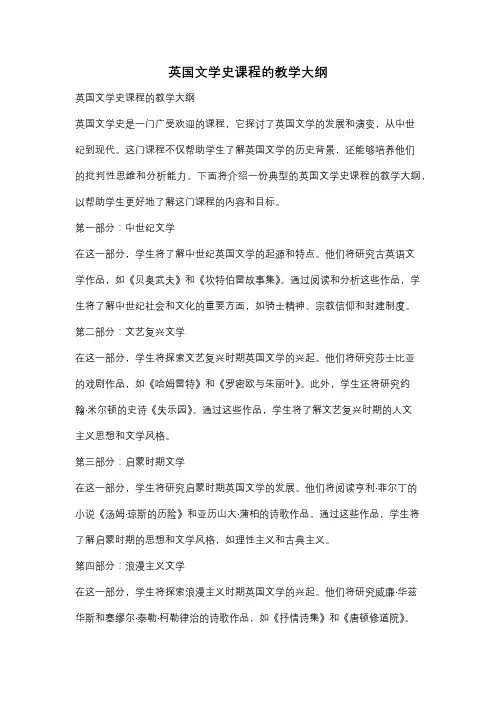
英国文学史课程的教学大纲英国文学史课程的教学大纲英国文学史是一门广受欢迎的课程,它探讨了英国文学的发展和演变,从中世纪到现代。
这门课程不仅帮助学生了解英国文学的历史背景,还能够培养他们的批判性思维和分析能力。
下面将介绍一份典型的英国文学史课程的教学大纲,以帮助学生更好地了解这门课程的内容和目标。
第一部分:中世纪文学在这一部分,学生将了解中世纪英国文学的起源和特点。
他们将研究古英语文学作品,如《贝奥武夫》和《坎特伯雷故事集》。
通过阅读和分析这些作品,学生将了解中世纪社会和文化的重要方面,如骑士精神、宗教信仰和封建制度。
第二部分:文艺复兴文学在这一部分,学生将探索文艺复兴时期英国文学的兴起。
他们将研究莎士比亚的戏剧作品,如《哈姆雷特》和《罗密欧与朱丽叶》。
此外,学生还将研究约翰·米尔顿的史诗《失乐园》。
通过这些作品,学生将了解文艺复兴时期的人文主义思想和文学风格。
第三部分:启蒙时期文学在这一部分,学生将研究启蒙时期英国文学的发展。
他们将阅读亨利·菲尔丁的小说《汤姆·琼斯的历险》和亚历山大·蒲柏的诗歌作品。
通过这些作品,学生将了解启蒙时期的思想和文学风格,如理性主义和古典主义。
第四部分:浪漫主义文学在这一部分,学生将探索浪漫主义时期英国文学的兴起。
他们将研究威廉·华兹华斯和塞缪尔·泰勒·柯勒律治的诗歌作品,如《抒情诗集》和《唐顿修道院》。
此外,学生还将研究玛丽·雪莱的小说《弗兰肯斯坦》。
通过这些作品,学生将了解浪漫主义时期的情感表达和个人主义思想。
第五部分:维多利亚时期文学在这一部分,学生将研究维多利亚时期英国文学的发展。
他们将阅读查尔斯·狄更斯的小说《雾都孤儿》和艾米莉·勃朗特的小说《简·爱》。
此外,学生还将研究阿尔弗雷德·丁尼生和罗伯特·布朗宁的诗歌作品。
通过这些作品,学生将了解维多利亚时期的社会问题和文学风格。
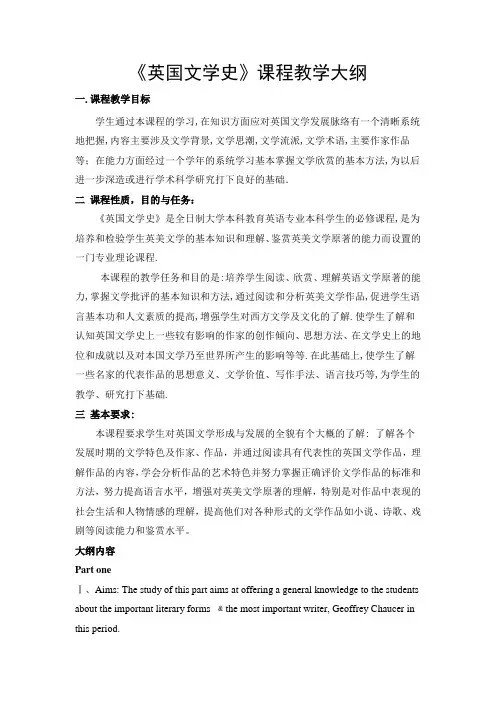
《英国文学史》课程教学大纲一.课程教学目标学生通过本课程的学习,在知识方面应对英国文学发展脉络有一个清晰系统地把握,内容主要涉及文学背景,文学思潮,文学流派,文学术语,主要作家作品等;在能力方面经过一个学年的系统学习基本掌握文学欣赏的基本方法,为以后进一步深造或进行学术科学研究打下良好的基础.二课程性质,目的与任务:《英国文学史》是全日制大学本科教育英语专业本科学生的必修课程,是为培养和检验学生英美文学的基本知识和理解、鉴赏英美文学原著的能力而设置的一门专业理论课程.本课程的教学任务和目的是:培养学生阅读、欣赏、理解英语文学原著的能力,掌握文学批评的基本知识和方法,通过阅读和分析英美文学作品,促进学生语言基本功和人文素质的提高,增强学生对西方文学及文化的了解.使学生了解和认知英国文学史上一些较有影响的作家的创作倾向、思想方法、在文学史上的地位和成就以及对本国文学乃至世界所产生的影响等等.在此基础上,使学生了解一些名家的代表作品的思想意义、文学价值、写作手法、语言技巧等,为学生的教学、研究打下基础.三基本要求:本课程要求学生对英国文学形成与发展的全貌有个大概的了解: 了解各个发展时期的文学特色及作家、作品,并通过阅读具有代表性的英国文学作品,理解作品的内容,学会分析作品的艺术特色并努力掌握正确评价文学作品的标准和方法,努力提高语言水平,增强对英美文学原著的理解,特别是对作品中表现的社会生活和人物情感的理解,提高他们对各种形式的文学作品如小说、诗歌、戏剧等阅读能力和鉴赏水平。
大纲内容Part oneⅠ、Aims: The study of this part aims at offering a general knowledge to the students about the important literary forms ﹠the most important writer, Geoffrey Chaucer in this period.Ⅱ、DemandsStudents are required to get acquainted with the general knowledge mainly by the way of self-study.Ⅲ、ContentsA .The Introduction to LiteratureB. Beowulf, the national epic of English PeopleC. Romance, an important literary form which is popular from 11th –14th CenturyD. Ballad, an important literary form which is popular in 15th century.E. Geoffrey Chaucer, the most important writer in this period. IV. Points emphasizedGeoffrey Chaucer and his masterpiece, Canterbury Tales.V. Direction for studyA. Getting acquainted with literature.B. Consulting reference books for the convince of self-study.VI. ExercisesQuestions to be answered.1. What is the theme of Beowulf?2. What are the differences between Romance & Ballad?3. Why is Geoffrey Chaucer considered as the greatest writer in early& medieval English literary period.VII. SummaryThe dearly and medieval English literary period is comparably a less important literary period. The most important issue of this period is something about Geoffrey Chaucer.Part Two. The English RenaissanceI. AimsThe study of this part aims at getting to know something about Renaissance Movement, humanism, Elizabethan drama and William Shakespeare.II. DemandsStudents are required to get acquainted the basic characters of Renaissance literature & master the corresponding part of Elizabethan drama and William Shakespeare.III. ContentsA.Introduction to Renaissance Movement & HumanismB.Elizabethan Prose1.Utopian prose2.Francis Bacon’s essaysC.Elizabethan Poetry1. General introduction to Elizabethan poetry2. Edmund Spenser, the poets’ poetD. Elizabethan Drama1.Introduction to Elizabethan drama2.Introduction to William Shakespeare’s literary career3.The themes in William Shakespeare’s works4.The comedy of William Shakespeare5. The tragedy of William Shakespeare6.The historical plays of William Shakespeare7.The sonnet of William Shakespeare8.Other Elizabethan DramatistsIV. Points emphasizedA. Elizabethan dramaB. William ShakespeareV. Direction for studyA.Read as many works of William Shakespeare as possibleB.Consult the reference books to have a general knowledge on Renaissance literatureVI. Exercises1. What is your understanding of English Renaissance Movement?2. What is your comment on William Shakespeare3.What is your comment on Hamlet?4.What is your comment on The Merchant of Venice?VII. SummaryRenaissance period is one of the most important literary periods in English literary history, which witnesses the prosperity of prose, poetry and drama. Yet Elizabethan drama is the most important literary form in this period, William Shakespeare is the great writers in the world as well as in Great Britain. It is rather necessary for us to have a thorough going study on him.Part Three. The Period of English Bourgeois RevolutionI. AimsThe study of this part aims at providing students with a general knowledge of English revolutionary period & detail information of John Milton & John Bunyan.II. DemandsStudents are required to grasp the main idea of the literary achievement of this century and master the corresponding part to introduce John Milton & John Bunyan.III. ContentsA.Introduction to the two dominant literary thoughts in this period1.Revolutionary spirit2.Anti revolutionary tendencyB.John Milton1.John Milton, the great pamphleteer2.John Milton, the greatest poet3.Paradise Lost, the masterpiece of John MiltonC.John Banyan1.John Banyan, the great prose writer2.Pilgrims Progress, the masterpiece of John MiltonD.Metaphysical poets & Cavalier PoetsIV. Points EmphasizedJohn Milton the great pamphleteer and greatest poetV. Direction for studyA.Getting to know something about English revolutionB.Reading Paradise LostVI. ExercisesQuestions to be answered.1.What is your common on Milton Paradise LostVII. SummaryThe period is comparably less important than other period, and the most significant issue is to master the great achievement of John Milton & masterpiece of him: Paradise Lost.Part Four. The Eighteenth CenturyI. AimsThe study of this part aims at providing students with the knowledge of Enlightenment movement. Neo-classicism and realistic literature.II. DemandsStudents are required to study eighteenth century as an enlightenment century & Enlightenment movement as an intellectual movement but only a literary movement. Realistic literature is the most important literary tread they should master.III. ContentsA.Introduction to Enlightenment movementB.Introduction to Neo-classicism and Alexander PopeC.Brief introduction to Joseph Addison & Richard Steele1.The basic characteristics of 18th century English realistic novel.2.Daniel Defoe & Jonathan Swift3.Detail study of Henry FieldingD.Sentimentalist writers and pre-romanticism writersIV. Points EmphasizedA.Enlightenment MovementB.Realistic novelV. Direction for studyA.Having a comprehensive study of Enlightenment movementB.Reading as many realistic novels in period as possibleVI. ExercisesQuestions to be answered1.What is the influence of 18th century Enlightenment thought on literature2.What are the basic characteristics of 18th century English realistic novel?3.What do we say Henry Fielding is the greatest realistic novelist in 18th century?VII. SummaryEighteenth century is a very important period in English literary history. Enlightenment thought is the dominant literary thought prevailing in the whole century, upon the influence of the Enlightenment thought, there emergesNeo-classicism in poetry and prose, realism in the field of novel. To have a comprehensive study of Enlightenment thought and study realistic literature of this century is of vital importance for students to have a good understanding of this part of literary history in this period.Part Five. Romanticism in EnglandI. AimsThe study of this chapter aims at having a comprehensive understanding of the characters of romanticism and getting acquainted with a group of world famous romantic poets esp. William Wordsworth, Percy Bysshe Shelley, George Gordon Byron & John Keats.II. Demands1. Having a comprehensive study on Romanticism2. Having a detail study of romantic poetsIII. ContentsA. Detail introduction to romanticismB. Detail analysis of Lake poets1. William Wordsworth2. S. T. ColeridgeC. Detail analysis of active romanticists1. Percy Bysshe Shelly2. Gorge Gordon Byron3. John KeatsD. Brief introduction to romantic prose writersE. Brief introduction to Walter ScottIV. Point EmphasizedA. RomanticismB. Romantic poetsV. Direction for studyA. Getting acquainted with romantic literature through the comparison between romantic literature and classical literatureB. Reading as many romantic poems created in this period as possibleVI. Exercises1. Why does romantic poetry become popular in early 19th century?2. How can we appreciate a piece of poem?3. What’s your comment on bake poets4. What’s your comment on William Wordsworth?VII. SummaryThe part is one of another most important literary period in English period. The great achievement in this period lives in the poetic field. To study romantic poetry is the most important task of the students.Part Six. English Critical RealismI. AimsThe study of this part aims at cultivating the ability of students to appreciates, analysis the mot complex literary form, novel.II. RemandsStudents are asked to have a clear knowledge of realistic tradition in 18th century and have the solid foundation of English language.II. ContentsA. Introduction to critical realismB. Charles Dickens, the greatest critical realism writer1. A panoramic description of the English society in 19th century.2. Bitter criticism on all social evils3. Basic characteristics of his novel4. Detail analysis his representative worksC. William Makepeace ThackerayD. Women novelist1. Bronte sisters2. Mrs. Gaskell3. George EliotIV. Points EmphasizedA. The comprehensive understanding of critical RealismB. A comprehensive study of Charles DickensV. Direction for studyA. Making comparison between 18th century English realism and critical realismB. Reading as many critical realism novels as possibleVI. ExercisesA. Questions to be answered1. What is critical realism2.What’s your comment on Charles Dickens children images3. What are the similarities and difference of 18th century realistic novel and 19thcentury critical realism novel4. How do you understand the image of Jane Eyre in Charlotte Bronte’ Jane Ey re?B. Essay writing: writing an essay on Charles DickensVII. SummaryCritical realism represents the greatest achievement of English writers in English literary history. The novels of Charles Dickens give a panoramic description of the social condition at that time in the second half of 19th century. All critical realism writer have made painstaking efforts to enable English literature achieve her maturity. To have a thorough-gong study of critical realism literature is of great significant to the students.Part Seven. Prose writers and Poet of the mid and late 19th centuryI. AimsThe study of this part aims at providing students with general knowledge of prose writers and detail information of Victorian Poets.II. DemandsStudents are requirement to make full use of the textbook and all kinds of information channels to get acquainted with Victorian literature.II. ContentsA. Introduction to Victorian periodB. General survey on prose writerC. Detail Analysis of Victorian poets1. Tennysona. Tennyso n’s life and careerb. “In Memoriam”c. “The Idylls of the king”2. The Browning’sa. Browning’s early life careerb. Elizabeth Barrett (Mrs. Browning)c. Browning’s Main Achievement in poetryd. Browning’s short lyricsD. General survey on literary trends at the end of the century1. Naturalism2. Neo-romanticism3. AestheticismIV. Points EmphasizedVictorian PoetsV. Direction for studyA. Consult as many reference books as possibleB. Read short lyrics of Victorian writersVI. Exercises1. What is Browning’s main achievement in poetry2. What is naturalism?3. What is your comment on aestheticism?VII. SummaryThe period is notable main because of the literary and social criticism represent by Carlyle Ruskin. The development of English poetry, of course, did not stop. New poets appeared who wrote poems under the influence of their romantic predecessors and did much to perfect the form of English poetry. Another significant literary phenomenon appeared in the end of this period is the arising of new literary trends especially the appearance of naturalism and aestheticism.Part Eight Twentieth Century English LiteratureI. AimsThe study of this part aims at providing students with clear idea about Modernism literature and the new characters of realistic literature in 20th century.II. DemandsStudents are required to have a comprehensive study of modernism literature and master the new techniques wired by modernist writers.III. ContentsA. General introduction to English novels in 20th century.B. Thomas Hardy1. Life and work2. “Tess of the D’UrbervillesC. The Irish Dramatic movement:Bernard ShawD. Modernism in poetry1. Imagism Movement2. W.B. Yeats3.T.S. EliotE. The Psychological Fiction1. Introduction psychological fiction2. D.H. Lawrence3. The stream of Consciousness school of novela. James Joyceb. Virginia WoolfIV. Points emphasizedModern literatureV. Direction for studyA. Read as many works of modernist writer as possibleB. Get acquainted with new techniques of modernist writersVI. Exercises1. What is modernism2. What is your comment on imagist movement3. What is your comment on stream of conscious novels?4. How do you understand D.H Lawrence’s new relation ship between man and woman?VII. SummaryThis period is one of the most important literary periods in English literary history. We can find from the works of realistic writers in this period the inheritance of the literary tradition of the last century and also the arising of new literary trend of modernism. Modernism literature is the most important literary achievement of 20th century and we can find the best refection of modernism from the works of D.H Lawrence, James Joyce and Virginia Woolf.六、课程的有关说明本大纲是依据1999年国家教育部批准实施的高等教育英语专业英语教学大纲并且依据本系办学特点及学生实际情况而编写的.本课程大纲的教学对象是师范本科英语专业三年级学生。
一.作家作品连线1.Geoffrey Chaucer乔叟——The Canterbury Tales(坎特伯雷故事),The Book of The Duchess(公爵夫人之书)、The Parliament of Fowls(百鸟会议)The House of Fame(声誉之堂)、Troilus and Criseyde(特罗勒斯与克丽西德)2.William Shakespeare莎士比亚——Hamlet, Romeo and Juliet, SonnetThe Merchant of Venice,Henry IV,Twelfth Night,King Lear,Macbeth 3.Francis Bacon培根——(Essays)Of Marriage and Single Life(轮婚姻和单身), Of Studies4.John Donne邓恩(Metaphysical poems玄学派诗人)-— Song and Sonnets (歌与十四行诗), Holy Sonnets(圣十四行诗)5.John Milton 弥尔顿—— Paradise Lost(失乐园)、Paradise Regained(复乐园)Samson Agonistes(力士参孙)6.Daniel Defoe笛福——The Life and strange Surprising Adventures of Robinson Crusoe(鲁滨孙漂流记)、Captain Singleton(辛格顿船长)、Moll Flanders(摩尔·弗兰德斯)A Journal of the Plague Year(大疫年日记)、Roxana (罗克萨娜)7.Jonathan Swift斯威夫特——Gulliver’s Travel s(格列佛游记)A Tale of a Tub (一只桶的故事),A Modest Proposal(一个温和的建议)8.William Blake布莱克——Song of Innocence(天真之歌),Song of experience(经验之歌), Poetical Sketches(诗的素描), The Book of Thel(塞尔书)9.Robert Burns彭斯——Auld Lang Syne, A Red Red Rose,10.William Wordsworth华兹华斯——I Wandered Lonely as a Cloud11.Samuel Taylor Coleridge柯勒律治——Kubla Khan(忽必烈汗),BiographiaLiteria (文学传记)、Lyrical Ballads (抒情歌谣集)12.Jane Austen简·奥斯丁—- Pride and Prejudice二、术语解释1、Epic(史诗): A long narrative poem telling about the deeds of a great hero and reflecting the values of the society from which it originated. It started in the 5th century, Beowulf was an important epic。
Part 1 The Anglo—Saxon Period(449-1066)秧格鲁-撒克逊时期1.Historical BackgroundCelts 400B.C. Romans 50B.C.Anglo—Saxons 450A.D Norman Invasion 1066A.D.Roman empire从albion撤军,teutonic tribes(包括angles, Saxons,jutes)(条顿人or日耳曼人)陆续登陆此地2. Literature 1,pagan异教徒文学2 christian基督徒文学alliterative verse头韵诗Epic: Beowulf贝奥武甫(Denmark背景)(the hall heorot鹿庁,grendel:a monster half-human)1) Oral origin, recited in court, handed down in generations until finally it was recorded by certain poet.上下部分由pagan写,插入由christian写2) a mixture of history and legend.,england’s national epic民国史诗Part II The Anglo-Norman Period(1066-1350)秧格鲁-诺曼时期1.Historical BackgroundRoman conquest,接着是english conquest,最后是norman conquest。
The Norman Conquest in 1066Duke William of Normandy claimed himself William I, King of England.(the battle of hastings 希斯廷战役)Kings—Barons男爵—Knights, a feudal system of hierarchy统治集团was formed2.The languageUpper classes: French, Latin The common people: Old EnglishThree languages co-existed in England. French became the official language used by the king and the Norman lords; Latin became the principal tongue of church affairs and in universities; and Old English was spoken only by the common English people.3.The literatureRomance was a type of literature that was very popular in the Middle Ages. It is about the life and adventures undertaken by a knight.It reflected the spirit of chivalry骑士制度. The content of romance: love, chivalry and religion. It involves fighting, adventures.Subject matter:Geoffrey’s History杰弗里《史记》,riming chronicles押韵编年史,metricalverse格律诗体,doggerel verse打油诗体1)the Matter of France eg. Charlemagne and his peers查理曼大帝和他的骑士2)Matter of Greece and Rome eg Akexabder亚历山大大帝3)Matter of Britain tales having for their heroes Arthur and his knights of the Round Table3.main literatureSir Gawain and the green knight.高文爵士和绿衣骑士(arthur,gawain,green knight, morgain the fay-woman妖精摩根, the green girdle绿腰带)Part III Geoffrey Chaucer (1340—1400)杰弗里.乔叟时期1.Historical BackgroundHe was living at the same time as the writer of Sir Gawain.In 1350 AD, 100 Years' War between England and France.The English won, they controlled large French territory领土. The Henry VI lost it all. He is father of English poetryWar of the Roses 1455-1485 AD2.What's middle ages like?1). The medieval society: hierarchy 等级制度social system.2). Another important thing in the medieval society is Christianity基督God-centered thinking, mind ideology思想体系3.Life and work of ChaucerChaucer lived between (1340-1400). His life is closely connected with the King and the royal family. Chaucer is working in a royal family as a page小侍臣. He married the sister of Gaunt's wife. He became a government official.He is very much exposed to the influence of Italy of the culture. E. G. Dante但丁, Patriarch,主教Boccaccio-the Decameron薄伽丘著《十日谈》,Chaucer chose the metrical form which laid the foundation of the English tonico-syllabic verse.乔叟第一次在英国用韵脚韵律诗形式来创作诗歌,开创了英国文学以重音-音节为基础的格律诗先河。
Part1 Old and Medieval English Period◆ Background1Old English Period 古英语时期(1)Roman Conquest 罗马征服(2)English Conquest 英国征服2Medieval English Period 中世纪英语时期(1)Danish Invasion 丹麦人入侵(2)Noman Conquest 诺曼底征服◆ Representative Writers and Their Works 1Beowulf 《贝奥武甫》2Geoffrey Chaucer《杰弗里﹡乔叟》founder of English poetry; The Canterbury Tales (maincontents; 124 stories planned, only 24 finished;written in Middle English; significance; form:heroic couplet)(1)Troilus and Criseyde 《特洛勒斯和克莱西》(2)TheCanterbury Tales 《坎特伯雷故事集》3King Alfred the Great (849~901)and The Anglo-Saxon Chronicle( 阿尔弗雷德王( 849~901) 和《盎格鲁-撒克逊编年史》4Robin Hood Ballads 《罗宾汉民谣》. Character of Robin Hood1.Robin Hood--- A legendary English hero of many ballads,who robbed the rich to give to the poor; a popular modelof courage, generosity and justice.2. strong, brave, clever, tender-hearted, affectionate.Hatred to the cruel oppressors, love for the poor and the downtrodden 5William Langland and Piers the Plowman 威廉﹡朗兰和《耕者皮尔斯》(1) Piers the Plowman 《耕者皮尔斯》Literaty Terms 名词解释1Allegory 寓言2Alliteration 头韵3Ballad 民谣1.A short narrative poem with stanzas of two or four linesand usually a refrain. The story, folklore popularlegends. straightforward verse, s with graphic simplicity and force. suitable for singing generally written inballad meter , with the last words of the second andfourth lines rhyming.2.the subjects of Ballad:(1) the struggle of young lovers who are fight against the feudalism(2)t he conflict between love and wealth (3) the cruelty ofjealousy (4) the criticism of the civil war (5) thematters of class struggles.4Epic 史诗5Lay 短叙事诗6Romance 传奇(1).The basic material of medieval romance is knightlyactivity andadventure; we might best define medieval romance as astory of adventure--fictitious, frequently marvelous or supernatural--in verse or prose.(2).A long composition describing the life and adventures of a noble hero. The central character was the knight, a man of noble birth skilled in the use of weapons who was very devoted to the king or to the church.(3).One who wanted to be a knight should serve patiently until he was admitted to the knighthood with solemn ceremony and the swearing of oaths.The Nature of the Romance:(4). The Nature of the Romance:1)Themes: Loyalty to the king and the lord, which wasthe corner-stone of feudal morality.2)The audience was of noble people from the court orthe castle.3)The Romance had nothing to do with the commonpeople.4)The Romance were written for the noble, of the nobleand in most cases by the poets patronized by thenoble.Part2 The English Renaissance 文艺复兴时期文学◆ Background◆ The Renaissance and Humanism 文艺复兴与人文主义◆ The Flourishing of English Literature 英格兰文学的繁荣1The English Bible 英文圣经霍尔希德的《编年史》2The English Drama思想家:托马斯*莫尔《乌托邦》埃德蒙*斯宾塞《仙后》散文家:佛朗西斯*培根《随笔》最具才华的大学才子:克里斯托弗*马洛《帖木儿》《马尔他的犹太人》《浮士德博士》造诣最高的剧作家和诗人:莎士比亚◆ Representative Writers and Their Works1Bacon*francis 佛朗西斯*培根(1561~1626)2Howard *Henry ,Earl of Surry 亨利*霍德华,萨里伯爵(1517~47) 3 Jonson*Ben 本*琼森(1572~1637)(1) Everyman in His Humour 《个性互异》(2)Barthlomew Fair 《巴梭罗缪市集》4 Lyly *John (1554?~1606)5Marlowe *Christopher 克里斯托弗*马洛(1564~93)(1)Tamburlaine the Great 《帖木儿大帝》(2)Doctor Faustus 《浮士德博士》(3)The Jew of Malta 《马耳他的犹太人》6More*Thomas 托马斯*莫尔(1478~1535)(1)Utopia 《乌托邦》7Sidney*Sir Philip 菲利普*锡德尼(1554~86)◆ Background(1)Astrophel and Stella 《爱星者和星星》(2)Defence of Poesie (or Apology for Poetry)《为诗辩护》8Spenser*Edmund 埃德蒙*斯宾塞(1552~99)(1)The Faerie Queene 《仙后》(2)The Shepherd 's Calender 《牧羊人日记》(3)Amoretti 《爱情小唱》9Shakepeare*William 威廉*莎士比亚(1564~1616)(1)Hamlet 《哈姆雷特》(2)Othello 《奥赛罗》(3)King Lear《李尔王》(4)Macbeth 《麦克白》(5) The Merchant of Venice《威尼斯商人》(6) Henr yⅤ《亨利五世》Literaty Terms 名词解释1Alexandrine 亚历山大诗行 2 Blank verse 无韵诗或素体诗 3 Comedy 喜剧 4 Essay 小品文 5 Euphuistic style 绚丽体 6 History Plays 历史剧7 Humanism 人文主义8 Interlude 插剧9 Masques,or masks 假面具10 Miracle Plays or Mystery Plays 神秘剧11 Morality Plays 道德剧12 Reformation 宗教改革13 Renaissance文艺复兴14 Sonnet 十四行诗15 Spenserian stanza 斯宾塞诗节16 Stanza 诗节17 Three Unites 三一原则18 Tragedy 悲剧Part 3 The Period of English Bourgeise Revolution英国资产阶级革命时期◆ Background◆ Literaty Features and Work in the Period of the EnglishBourgeoise Revolution 资产阶级革命时期文学特点及作品1 最著名的诗人:Milton *John 约翰*米尔顿(1608~1674) 作品:史诗Paradise Lost《失乐园》Paradise Regained《复乐园》诗歌戏剧:SamsonAgonistes《力士参孙》2玄学派:Donne*John 约翰*邓恩(1572~1631)Herbert*George 乔治*赫伯特(1593~1633) Marvell *Andrew 安德鲁*马维尔(1621~1678)3骑士学派: 约翰*萨克令;理查德*勒夫莱斯;托马斯*卡鲁;罗伯特*赫瑞克4小说体散文:Bunyun *John 约翰*班杨(1628~1688) 作品:The Pilgrim 's Progress《天路历程》5文艺复兴后期复杂、大胆、奢侈的文学形式逐渐让步于简单、清晰、克制和规则的形式Dryden *John 约翰*德莱顿(1631~1700)成为当时重要的诗人和批评家作品:剧本~All for Love 《一切为了爱》;长诗~《亚布萨伦与阿奇图菲儿》;散文An Essay ofDramatic Poesy《论戏剧诗》◆ RepresentativeWriters and Their Works1 Browne*Sir Thomas 托马斯*布朗爵士(1605~1682)(1)Religio Medici 《医生的宗教》(2)Hydriotaphia ,orUrn Burial 《翁葬》2 Bunyun *John 约翰*班杨(1628~1688)(1)The Pilgrim 's Progress《天路历程》3Burton *Robert 罗伯特*波顿(1577~1640)(1)The Anatomy of Melancholy 《忧郁的解剖》4Donne*John 约翰*邓恩(1572~1631)(1) Songs and Sonnets《歌与十四行诗》(2) Holy Sonnets 《圣诗》5Dryden*John 约翰*德莱顿(1631~1700)(1) All for Love 《一切为了爱》(2)An Essay of DramaticPoesy 《论戏剧诗》6Herbert *George 乔治*赫伯特(1593~1633)(1)The Temple 《圣堂》7Herrick *Robert 罗伯特*赫瑞恩(1591~1674)8Marvell *Andrew 安德鲁*马维尔(1621~1678)9Milton *John 约翰*米尔顿(1608~1674)(1) Paradise Lost 《失乐园》(2) Paradise Regained《复乐园》(3) Samson Agonistes《力士参孙》(4) L 'Allegro and Ⅱ Penseroso 《快乐的人》和《幽思的人》(5)Lycidas 《莱西达斯》Literaty Terms 名词解释1Baroque 巴罗克式风格 2 Cavalier Poet 骑士派诗人3 Conceit 奇思妙喻 4 Elegy 挽歌 5 Metaphysical Poet 玄学派诗人 6 Pueianism 清教主义7 Restoration Comedy 复辟时期的喜剧Part 4 The Eighteenth Century18 世纪与古典主义英国文学◆ Background◆ Literary Feature and Works in 18 th Century18 世纪文学特点及作品1The Dominant ideology in the Literary Field 文学领域中的主流意识形态18 世纪的英格兰也称为( Age of Enlightment )启蒙主义时代或 ( Age of Reason)理性主义时代,启蒙主义思想在整个18 世纪居于主导地位。
A Brief Outline of British Literature(英国文学概要)I. The early and Medieval literature(早期和中世纪文学)1. Beowulf (贝奥武夫,有记载的最早的一部英国文学作品)2. Geoffrey Chaucer’s The Canterbury Tales。
(杰弗里乔叟的坎特伯雷故事集)II. The English Renaissance (1485-1603) (英国文艺复兴时期)1. Edmund Spence r’s The Shepherd's Calendar and Faerie Queen(埃德蒙斯宾塞的牧羊人日记和精灵女王)2. Francis Bacon’s Essays(弗朗西斯培根的散文)3. William Shakespeare’s dramas(威廉莎士比亚的戏剧)III. The 17th century (1603-1660)1. The English Revolution (英国革命)2. John Milton’s Paradise Lost(弥尔顿的失乐园)3. John Bunyan’s Pilgrim’s Progress(约翰班扬的天路历程)IV. The Restoration and the 18th Century (1660-1798) (复辟与十八世纪)1. enlightenment (启蒙运动)2. neo-classicism:(新古典主义)a. John Dryden’s dramas(约翰德来端的戏剧)b. Ale xander Pope’s The Rape of the Lock (亚历山大蒲柏的夺发记)c. Richard Steele and Joseph Addison's essays(理查德斯蒂尔和约瑟夫艾迪生的散文)d. Samuel Johnson’s Dictionary(赛缪尔约翰逊的词典)3. rise of the novel writing:(小说创作的兴起)a. Daniel DeFoe’s Robinson Crusoe(丹尼尔笛福的鲁滨逊漂流记)b. Janathan Swift’s Gulliver’s Travels(贾纳森斯威夫特的格列佛游记)V. The Age of Romanticism (1798-1830)(浪漫主义时代)1. Pre-Romanticism : (前浪漫主义)a. William Blake (威廉布雷克英国诗人和画家)b. Robert Burn (罗伯特彭斯)c. William Wordsworth(威廉华兹华斯英国诗人)2. Romanticism (浪漫主义)a. P. B. Shelley (Percy Bysshe Shelley 珀西比西雪莱)b. G. G. Byron(George Gordon Byron 乔治戈登拜伦)c. J. Keats(John Keats 约翰济慈)3. Jane Austen’s novels(简奥斯丁小说)VI. The Victorian Age (1832-1901)(维多利亚时代)1. industrial revolution (工业革命)2. realism (现实主义)a. Charles Dickens (查尔斯狄更斯英国作家)b. Thomas Hardy(托马斯哈代英国小说家)c. Bronte sisters(勃朗特三姐妹)d. George Eliot(乔治艾略特)3. aestheticism: Oscar Wilde (唯美主义,奥斯卡王尔德)VII. The 20th century (1901-)1. two world wars(两次世界大战)2. modernism(现代主义)3. psychological fiction and stream of consciousness (心理小说与意识流)a. D. H. Lawrence (David Herbert Lawrence大卫赫伯特劳伦斯)b. James Joyce(詹姆斯乔伊斯)c. Virginia Woolf(弗吉尼亚伍尔夫)4. Poetry(诗歌)Definition of Literature :Literature refers to All written or spoken compositions ( discourses) designed to tell stories, dramatize situations and reveal thoughts and emotions, and also more importantly, to interest, entertain, stimulate, broaden and ennoble readers. (文学的定义:文学是所有口头或书面的成分设计讲故事,戏剧化情况,揭示思想和情感,而且更重要的是,兴趣,娱乐,刺激,拓宽和授予爵位的读者。
)What to learn in this course?1. historical and cultural background(历史文化背景)2. life story of the masters(大师们的人生故事)3. masterpieces introduction and features(代表作介绍与特色)4. some important literary terms and their meanings。
(一些重要的文学术语及其意义)Chapter I The Anglo-Saxon Period(449-1066)(第一章央格鲁撒克逊时期)Historical Background1.The early inhabitants in England (today) were Britons, a tribe of Celts, which was primitive people, living in tribal society. [Britain: the land of Britons.]2.The Roman ConquestIn 55 B.C., Julius Caesar invaded Britain. “Veni, vidi, vici”I come, I see, I conquer.1) Roman mode of life came across to Britain:theaters; baths? conquerorsnative Britons ? slaves2) London became an important trading center.3) Christianity was introduced to Britain.3.Roman Empire began to decline at the beginning of 5th Century. In 410 A. D. all the Roman troops went back to the continent and never returned. The Roman occupation ended. The aboriginal Celtic population of the larger part of the island was soon conquered and almost totally exterminated by the Teutonic tribes of Angles, Saxons and Jutes.Epic: or heroic poem, is applied to a work that meets at least the following criteria: it is a long verse narrative on a serious subject, told in a formal and elevated style, and centered on a heroic or quasi-divine figure on whose actions depends the fate of a tribe, a nation, or the human race.The Song of Beowulf1.Anglo-Saxon Poetry: poems, or songs by the Anglo-Saxon minstrels who sang of the heroic deeds of old time to the chiefs and warriors in the feasting-hall.2.Beowulf: 3182 lines, the national epic of the English people.3. A folk legend brought to England by Anglo-Saxons from their continental homes. It had been passed from mouth to mouth for hundreds of years before it was written down in the tenth century.The Story of Beowulf1.Beowulf is the nephew of Hygelac, King of the Geats, a people in Jutland, Denmark. News reaches him that Hrothgar, King of the Danes, is in great trouble. Hrothgar has built a great hall. But a terrible monster, Grendel, visits the hall from night and carries the warriors away. So the hall is deserted.On hearing the news, Beowulf sails for Denmark with fourteen companions and offers to fight the monster. After a feast of welcome, Beowulf and his companions lie down in the hall for the night. Then Grendel appears, seizes and devours one of Beowulf’s men. He next attacks Beowulf, who grapples with him single-handed, because weapons do not avail against him. After a terrible hand-to-hand combat, Grendel retreats mortally wounded, leaving one of his arms with Beowulf. Great rejoicing follows and next night the hall is once more full of joys and songs.2.But Grendel has a mother. She comes to avenge her son’s death by carrying away the chief counsellor of Hrothgar. Beowulf and his companions follow the bloody trail to the edge of a lake. Beowulf plunges into the water, finds the old she-monster and follows her into a hall under the waves. In the desperate combat his sword fails to bite. And at first he almost gets the worst of it if he does not by chance seize a big sword left by the giants of old time. With it he cuts off the head of the she-monster. There, too, he finds the body of Grendel himself and cuts off his head as well. With these trophies he goes back to the hall of the Danish king. The triumph is celebrated byfeasting and song. And Beowulf sails home to the land of the Geats.3.Now, he becomes king and reigns over his people for fifty years. Then it comes to pass that a fire dragon comes out of its den and belches forth its fire to burn the people. Beowulf is an old man now. But he bids farewell to his household and goes to seek the dragon with eleven companions. He fights it single-handed. Again the sword fails to bite, and the hero is enveloped in flames. The dragon is killed at last. But Beowulf is hopelessly wounded too. The poem ends with the funeral of the hero.Features of BeowulfAlliteration: is the repetition of a speech sound in a sequence of nearby words. The term is usually applied only to consonants, and only when the recurrent sound begins a word or a stressed syllable within a word. In Old English alliterative meter, alliteration is the principal organizing device of the verse line.Metaphorring-giver: kingsea-wood: shipHearth-companion: his attendant warriorsSwan’s bath or whale’s bath: seaUnderstatementNot troublesome: very welcomeNeed not praise: a right to condemnChapter II The Anglo-Norman PeriodI. Historical Background1. In the year 1066, the battle of Hastings.2. William, Duke of Normandy defeated the Anglo-Saxons.3. Feudalism: landlords and peasants4. The literature which they brought to England is remarkable for its bright, romantic tales of love and adventure, in marked contrast with the strength and somberness of Anglo-Saxon poetry.5. A large part of the French vocabulary.6. Adventures of King Arthur and His Knights of the Round TableII. Romance: chivalric romance or medieval romance, is a type of narrative that developed in twelfth-century France, spread to the literatures of other countries, and displaced the earlier epic and heroic forms. The romance is distinguished from the epic in that it does not represent a heroic age of tribal wars, but a courtly and chivalric age, often one of highly developed manners and civility. Its standard plot is that of aquest undertaken by a singl e knight in order to gain a lady’s favor; frequently its central interest is courtly love, together with tournaments fought and dragons and monsters slain for the damsel’s sake; it stresses the chivalric ideals of courage, loyalty, honor, mercifulness to an opponent, and elaborate manners; and it delights in wonders and marvels.III. Chivalry1. To never do outrage nor murder.2. Always to flee treason.3. To by no means be cruel but to give mercy unto him who asks for mercy.4. To always do ladies, gentlewomen and widows succor.5. To never force ladies, gentlewomen or widows.6. Not to take up battles in wrongful quarrelsChapter III Geoffrey Chaucer (1340?-1400)The Canterbury TalesChaucer’s contribution to the English languageChaucer’s language is vivid and exact. His verse is smooth. His words are easy to understand. He introduced from France the rhymed stanzasof various types, especially the rhymed couplet of iambic pentameter whichwas later called the “heroic couplet” to English poetry, instea d of the oldAnglo-Saxon alliterative verse. Though drawing influence from French, Italian and Latin models, he is the first important poet to write in the current Englishlanguage. His production of so much excellent poetry was an important factorin establishing English as the literary language of the country. Chaucer didmuch in making the dialect of London the foundation for the modern Englishlanguage.Popular BalladsBallad: A short definition of the popular ballad (known also as the folk ballad or traditional ballad) is that it is a song, transmitted orally, which tells a story. Ballads are thus the narrative species of folk songs, which originate, and are communicated orally, among illiterate or only partly literate people.Robin HoodThe Vision of Piers, the Plowman(by Langland)Sir Patrick Spens。